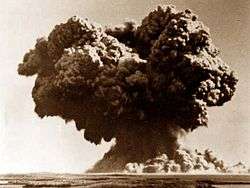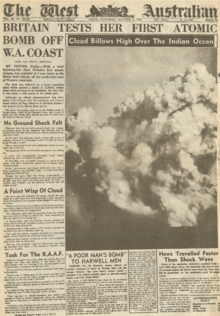Operation Hurricane
| Hurricane | |
|---|---|
 Hurricane exploded in the hold of a frigate | |
| Information | |
| Country | United Kingdom |
| Test site | Montebello Islands, Western Australia |
| Period | 1952 |
| Number of tests | 1 |
| Test type | barge |
| Max. yield | 25 kilotonnes of TNT (100 TJ) |
| Navigation | |
| Next test series | Operation Totem |
Operation Hurricane was the test of the first UK atomic device on 3 October 1952. A plutonium implosion device was detonated in the lagoon between the Montebello Islands, Western Australia, just over three years after the Soviet Union detonated a similar plutonium implosion device in August 1949.
Several key British scientists had worked on the Manhattan Project and after returning to the UK worked on the British atom bomb project, so unsurprisingly the weapon had a close similarity to the Fat Man (the device used against Nagasaki) weapon, although the McMahon Atomic Energy Act of 1946 prevented any British access to the US design data. The design used a hollow core,[1] unlike The Gadget tested at Trinity. This increased the expected yield of the bomb to 30 kilotons,[1] although the actual yield was closer to 25 kilotons. The bomb core used 7 kg[1] of plutonium produced mainly at Windscale (now Sellafield) in Cumbria with a low Pu-240 content of only 2%.[1]
Pu-240 is an unavoidable contaminant of Pu-239 produced by irradiation of uranium in a thermal reactor; its effect in a bomb core is to increase the risk of a "fizzle" or pre-detonation. The only way to keep it within acceptable limits at that time was to limit the time the reactor fuel was exposed in the reactors. The Canadian Chalk River plant supplied 5 kg of plutonium by April 1952,[1] and by August 1952 the Windscale plant had supplied 18 kg.[1] No records exist to show whether any of the Canadian material was used in the Hurricane test device; more than one fissile core was prepared for the trial,[1] each to a different design.[1]
To test the effects of a ship-smuggled bomb (a threat of great concern to the British at the time), Hurricane was exploded inside the hull of HMS Plym (a 1,370-ton River class frigate) which was anchored in 12 metres (39 ft) of water, 350 metres (1,150 ft) off Trimouille Island. The explosion occurred 2.7 metres (8 ft 10 in) below the water line, and left a saucer-shaped crater on the seabed 6 metres (20 ft) deep and 300 metres (980 ft) across.[2]
Summary
| Name [note 1] | Date time (UT) | Local time zone [note 2][3] | Location [note 3] | Elevation + height [note 4] | Delivery, [note 5] Purpose [note 6] |
Device [note 7] | Yield [note 8] | Fallout [note 9] | References | Notes |
|---|---|---|---|---|---|---|---|---|---|---|
| Hurricane | 3 October 1952 00:59:24 | aWST (8 hrs) | Montebello Islands, West Australia 20°24′27″S 115°33′14″E / 20.407445°S 115.554013°E | 0 - 2.7 m (8 ft 10 in) | barge, weapon effect |
American Mark 3 design, levitated pit | 25 kt | [4][5][6][7] | Exploded in the hold of the HMS Plym (a 1,370 short tons (1,240 t) River class frigate). |

- ↑ The US, France and Great Britain have code-named their test events, while the USSR and China did not, and therefore have only test numbers (with some exceptions – Soviet peaceful explosions were named). Word translations into English in parentheses unless the name is a proper noun. A dash followed by a number indicates a member of a salvo event. The US also sometimes named the individual explosions in such a salvo test, which results in "name1 – 1(with name2)". If test is canceled or aborted, then the row data like date and location discloses the intended plans, where known.
- ↑ To convert the UT time into standard local, add the number of hours in parentheses to the UT time; for local daylight saving time, add one additional hour. If the result is earlier than 00:00, add 24 hours and subtract 1 from the day; if it is 24:00 or later, subtract 24 hours and add 1 to the day. All historical timezone data are derived from here:
- ↑ Rough place name and a latitude/longitude reference; for rocket-carried tests, the launch location is specified before the detonation location, if known. Some locations are extremely accurate; others (like airdrops and space blasts) may be quite inaccurate. "~" indicates a likely pro-forma rough location, shared with other tests in that same area.
- ↑ Elevation is the ground level at the point directly below the explosion relative to sea level; height is the additional distance added or subtracted by tower, balloon, shaft, tunnel, air drop or other contrivance. For rocket bursts the ground level is "N/A". In some cases it is not clear if the height is absolute or relative to ground, for example, Plumbbob/John. No number or units indicates the value is unknown, while "0" means zero. Sorting on this column is by elevation and height added together.
- ↑ Atmospheric, airdrop, balloon, gun, cruise missile, rocket, surface, tower, and barge are all disallowed by the Partial Nuclear Test Ban Treaty. Sealed shaft and tunnel are underground, and remained useful under the PTBT. Intentional cratering tests are borderline; they occurred under the treaty, were sometimes protested, and generally overlooked if the test was declared to be a peaceful use.
- ↑ Include weapons development, weapon effects, safety test, transport safety test, war, science, joint verification and industrial/peaceful, which may be further broken down.
- ↑ Designations for test items where known, "?" indicates some uncertainty about the preceding value, nicknames for particular devices in quotes. This category of information is often not officially disclosed.
- ↑ Estimated energy yield in tons, kilotons, and megatons. A ton of TNT equivalent is defined as 4.184 gigajoules (1 gigacalorie).
- ↑ Radioactive emission to the atmosphere aside from prompt neutrons, where known. The measured species is only iodine-131 if mentioned, otherwise it is all species. No entry means unknown, probably none if underground and "all" if not; otherwise notation for whether measured on the site only or off the site, where known, and the measured amount of radioactivity released.
References
- 1 2 3 4 5 6 7 8 The National Archives, London, ES 1/11.
- ↑ "British nuclear test Operation Hurricane - secret reports to Winston Churchill and civil defense data obtained". Internet Archive. Retrieved 16 October 2015.
- ↑ "Timezone Historical Database". iana.com. Retrieved March 8, 2014.
- ↑ Cathcart, Brian (1994). Test of Greatness: Britain's Struggle for the Atom Bomb. Cambridge, UK: John Murray.
- ↑ Cooper, Malcolm B.; Lokan, Keith H.; Williams, Geoffrey A. (November 1, 1983). The Radiological Status of the Monte Bello Islands: May 1983 (PDF) (Technical report). Yallambie, VIC, Australia: Australian Radiation Laboratory. Retrieved December 18, 2013.
- ↑ Norris, Robert S.; Burrows, Andrew S.; Fieldhouse, Richard W. (1994). Nuclear Weapons Databook, Vol. 5: British, French, and Chinese Nuclear Weapons. Boulder, CO: Westview Press.
- ↑ Yang, Xiaoping; North, Robert; Romney, Carl (August 2000). CMR Nuclear Explosion Database (Revision 3) (Technical report). SMDC Monitoring Research.
Further reading
- Bird, Peter (1989) Operation Hurricane Worcester: Square One Publications. ISBN 1-872017-10-X First published: 1953.
External links
- AWE history
- Original AWE page available from archive.org
- British nuclear weapons testing in Australia
- Operation Hurricane - Ministry of Supply made documentary
- Better quality extract from the same video of the Hurricane Nuclear Test
- Atomic Forum
- Britain's Nuclear Weapons-From MAUD to Hurricane
- Operation Hurricane by National Archives of Australia - Vimeo
- Declassified AWRE reports and National Archives files on Operation Hurricane's scientific and civil defence implications